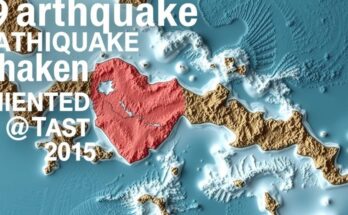A magnitude 4.0 earthquake struck 260km off the coast of Western Australia, detected at a depth of 10km. This occurrence follows a 4.1 magnitude earthquake in New South Wales that caused significant disruptions and was linked to potential aftershocks. Experts warn of continued seismic activity in both regions, emphasizing the need for community preparedness.
This week, a magnitude 4.0 earthquake was recorded off the coast of Western Australia, approximately 260 kilometers from Albany, at a depth of 10 kilometers, occurring at about 10:45 AM local time on Thursday. This seismic event follows closely on the heels of a magnitude 4.1 earthquake that impacted New South Wales two days prior, disrupting power for numerous residents. The earlier quake struck near Denman, in the Upper Hunter Region, significantly affecting the areas of Hunter Valley, Central Coast, Scone, and Penrith, with more than 300 individuals reporting sensations of the tremor. Seismologists have indicated that the recent earthquakes may indicate an ongoing series of seismic activities. In particular, Dr. Hadi Ghasemi, a senior seismologist at Geoscience Australia, explained that the New South Wales quake was part of a “swarm sequence”, suggesting the potential for additional seismic activities in the region. Recent data reveals that since a magnitude-4.7 quake was recorded in August, over fifty earthquakes have occurred in the same vicinity, with four measuring over magnitude 4. Residents in areas affected by these quakes, such as Muswellbrook, have been advised to prepare for a significant number of aftershocks. Dr. Ghasemi cautions, “In earthquake swarms, you have a series of earthquakes with similar size magnitudes—it’s not like an aftershock sequence.” He emphasized that smaller aftershocks often follow magnitude-4 earthquakes, although ongoing swarm activities could lead to tremors lasting months or even years.
Earthquakes are a natural phenomenon that occur due to the shifting of tectonic plates beneath the Earth’s surface. In regions like Western Australia and New South Wales, the seismic activity sometimes manifests as small tremors, which can vary in magnitude. The recent magnitude 4.0 earthquake off the coast of WA, combined with the previous 4.1 magnitude quake in NSW, has drawn attention to potential ongoing seismic activities in both regions. Seismologists use terms like “earthquake swarm” to describe situations where multiple seismic events occur within a certain timeframe in nearby locations, underscoring the possibility of further tremors.
In conclusion, the recent magnitude 4.0 earthquake off the coast of Western Australia and the preceding magnitude 4.1 quake in New South Wales highlight the ongoing seismic activities affecting these areas. Experts indicate that the residents should brace themselves for potential aftershocks and further tremors as both events are part of a larger pattern of seismic activity. As observed, earthquake swarms can lead to extended periods of seismic unrest, reminding communities of the importance of preparedness in such regions.
Original Source: www.dailymail.co.uk




